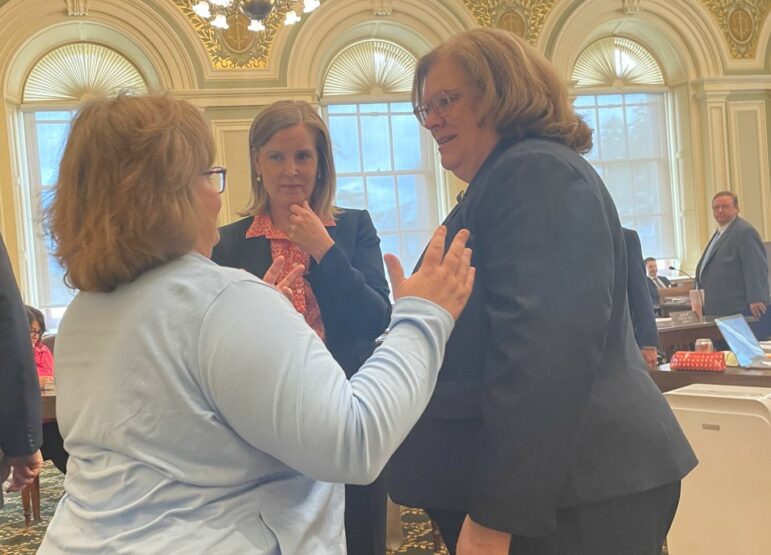Power to the People is a column by Donald M. Kreis, New Hampshire’s Consumer Advocate. Kreis and his staff of four represent the interests of residential utility customers before the NH Public Utilities Commission and elsewhere.
By DONALD M. KREIS, Power to the People
Kremlinology is out of fashion these days, but it is not an entirely useless skill.
Yes, it is no longer necessary to scan the dour faces and bland public remarks of elderly politburo members, hoping to figure out what was really going on in the Soviet Union. (That, as it happens, is thanks to me. I arrived in Moscow for the first time in December of 1991, with the red Soviet flag still flying over the Kremlin. When I left two weeks later, that flag had been replaced forevermore by the Russian tricolor. But I digress.)
Nowadays, the skills of a Kremlinologist can be put to good use by analyzing the public remarks of Gordon van Welie, CEO of the regional grid operator ISO New England.
Just as Punxsutawney Phil emerges from his hole in Pennsylvania every February to opine in groundhog fashion about winter as it wanes, so does van Welie pop up every year at around this time to freak out journalists and policymakers about winter as it waxes. As to the bulk power transmission system van Welie oversees, is this the winter we reach the limit when the need for heat and light soars amid snow and cold?
As reported by InDepthNH’s veteran Kremlinologist Garry Rayno, recently van Welie declared: “We operate in winter very close to the edge here in New England and we have for a long time. . . . The 15 million people in New England need to understand the precarious position we are in when we have an extended period of extreme cold weather.”
In other words, as they used to say in the Union of Soviet Socialist Republics (USSR), this year we have nothing like we have never had nothing before.
Our grid’s precarious condition is thanks, in no small part, to an over-reliance on electricity produced via the combustion of natural gas. We make more than half of our electricity that way, relying on fuel that comes from distant places like western Pennsylvania, Texas, and even Alberta in the Canadian tundra.
The problem is that pipeline capacity is in short supply. In an extended cold spell, like the one last experienced in late December of 2017 and early January of 2018, customers who heat with natural gas have priority access. Stockpiled backup fuel – by which I mean coal and fuel oil – dwindles in such a scenario.
So, when bitter cold persisted well into January 2018, there was the very real possibility that the folks in the ISO New England control room would have to start ordering rolling blackouts. Had demand actually exceeded available supply, the only alternative to such rolling blackouts would have been an uncontrolled cascading failure – i.e., a disaster.
But none of that occurred in 2018. Could it happen this winter?
Well, again relying on Garry Rayno’s account, van Welie noted that demand is actually projected to decline this winter compared to last. As ISO New England has observed, forecasters actually expect a relatively mild winter.
But, unfortunately, a couple of things are different this time around.
First, wholesale natural gas prices went haywire in October thanks to a perfect storm –literally including bad weather in the form of Hurricane Ida which slammed the Gulf Coast in late August. Less gas than usual went into storage over the summer, because it was unusually hot and lots of natural gas generators around the U.S. were running as people were enjoying their air conditioning. And worldwide demand for our natural gas, exported by boat in liquified form, soared, which means we are competing for fuel with others around the planet.
Thus there is less natural gas available to run electricity generators in New England this winter.
Second, some New England generators pressed into service when demand soars run on fuel that must be delivered by truck. The same supply chain problems that threaten to delay people’s holiday gifts could make it challenging for generators to get timely supplies of fuel oil, coal, and even natural gas.
I remain convinced it is unlikely we will suffer rolling blackouts this winter. But, because I wish I could rule out the possibility of rolling blackouts more confidently, I’ve looked into what such semi-planned outages would actually be like.
For customers of Eversource and for members of the New Hampshire Electric Cooperative, the decisions on which specific circuits to shut off would be made in the Manchester control room of Eversource. According to the company, “the pace of rotating outages will be heavily dependent on the situation at the time” but Eversource’s system operators will “methodically rotate feeders to the extent possible in a two- to four-hour window.”
In which order would Eversource rotate through its outages? That’s information the utility does not publicly disclose, beyond stating that it has no intention of turning off any circuit that serves a hospital.
The plan is similar for customers of Liberty Utilities, where the decisions will be made in that company’s Londonderry control room. Liberty’s electric distribution network is not as automated as Eversource’s and, thus, a lot of the actual switching associated with rolling outages would take place in the field.
Therefore, Liberty’s plan calls for rolling outages of eight hours in duration. That’s a long time to be without power on a cold winter’s day.
As for Unitil, I don’t know whether their plan for rolling outages looks like Eversource’s, Liberty’s or something else. The company did not respond to two queries, posed through the utility’s lawyers.
You don’t need a Kremlinologist to understand my perspective on these things in my capacity as the state’s official advocate for residential utility customers. Rolling blackouts are a small but real possibility this winter.
If they come, they will be disruptive and perhaps a bit chaotic. The utilities have been rehearsing, but nothing like this has happened for real in New Hampshire for many decades if ever.
On the other hand, there would be plenty of advance warning. There would have to be an extended cold spell, and rolling blackouts would be preceded by days of entreaties from ISO-New England, the utilities, and state officials to curtail electric usage when possible.
Cold weather in Texas prompted an electricity fiasco last February beginning on Valentine’s Day. It was a reliability scenario worthy of the Soviet Union; some people had no power for days and days. That is not a scenario Granite Staters should expect. In that sense – trust me – we are not back in the USSR.





